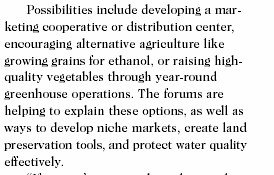Henry S. Cole, Ph.D.
There is a remarkable opportunity in the Prince Georges’ County to create new economic opportunities that will help to preserve the rural character of the county’s rural areas. This approach uses the County’s power to promote agricultural and recreational opportunities for local businesses. Part 1 focuses on farming and the growing importance of locally grown products. Parts 2 and 3 will focus on recreation and renewable energy resources in rural areas.
Lets look 5 and 10 years into the future. What are the trends? Consumer demand for fresh, locally grown food products is on the rise. Secondly, energy prices will continue to rise (don’t take the current dip as anything permanent). This means that the costs of transportation, refrigeration, freezing and processing will all increase. Thus, that apple that comes from Chile or spinach from California will be a lot more expensive than one grown locally. The third mega-trend is that the Washington-Baltimore urban corridor is one of the fastest growing in the nation. This huge market food will get even bigger.
What does all of this mean? It means that open space – now a prime target for homes will become increasingly valuable for its food growing potential. There are enormous opportunities for business and job creation – not only for 500 acre and 100 acre farms, but for 5 and 10 acre farms. In coming issues of this Blog we will provide specific examples of local farming enterprises (both big and small) that point to the future.
What is the County’s Role? The County has already initiated a Purchase Development Rights (PDR) – conservation easement – that will enable farmers to keep farming. Farmers have already lined up and the demand far exceeds the demand at this point. But the program can be expanded. Secondly, the County can begin to act to provide technical assistance, business assistance and above all act as a broker for “locally grown.” Its one thing when a farmer goes to Safeway or Giant – it’s far more effective when the County to negotiate with these companies for dedicated space.
Other areas are moving forward. The Talbot County, MD example is given in a separate article below. The following entry focuses on Michigan’s increasing recognition of the economic importance of its diverse agriculture and locally grown products.
Forecast sees almost 2,000 new jobs, jump in farm profits
By Patty Cantrell and Michael Hamm
Great Lakes Bulletin News Service

Beulah — Robust efforts to increase sales of fresh, local foods in Michigan could significantly boost employment and personal income across the state, according to a new study by university and nonprofit researchers.
Eat Fresh and Grow Jobs examines six different scenarios in which existing farmers double or triple the amount of fruits and vegetables they sell into fresh produce markets, such as wholesale grocery sales and farmers markets. Using an economic modeling tool customized to Michigan, the study determined the shift could increase net farm income in Michigan by $164 million, or nearly 16 percent. As farm families spend this new income, the study shows they could generate up to 1,889 new jobs across the state and $187 million in new personal income from those jobs.
For the rest of the article: place the cursor anywhere in the MLUI box below and click.